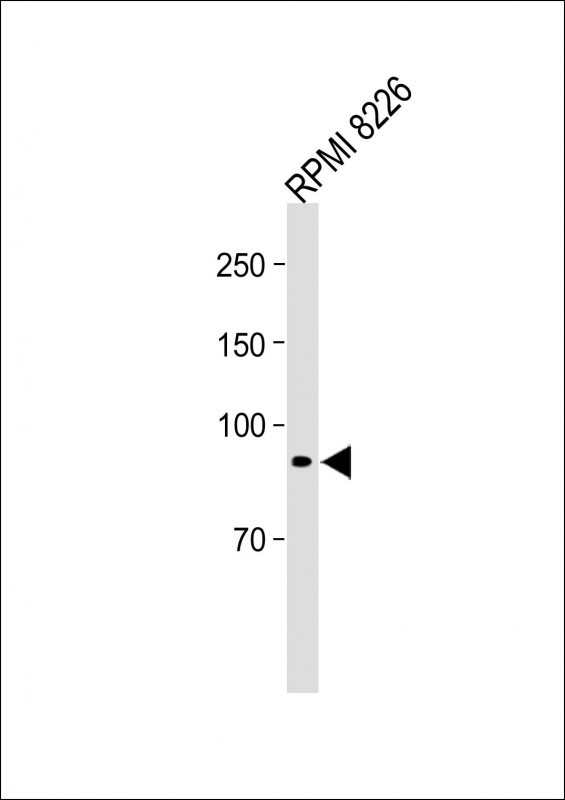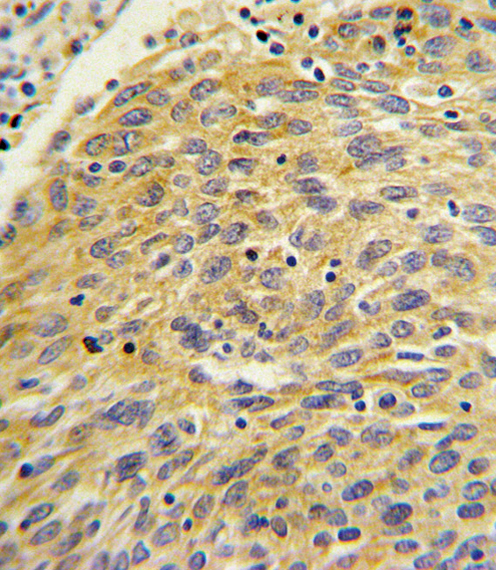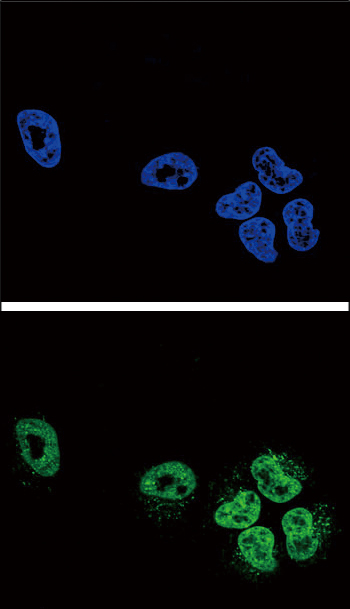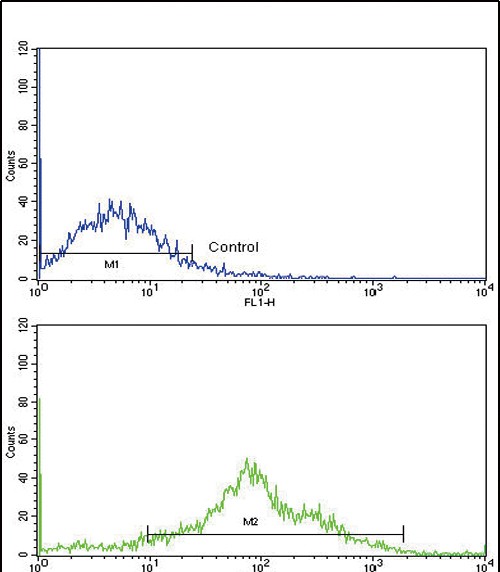PLA2G4A Antibody (Center)
Affinity Purified Rabbit Polyclonal Antibody (Pab)
- 产品详情
- 实验流程
- 背景知识
Application
| WB, IHC-P, IF, FC, E |
|---|---|
| Primary Accession | P47712 |
| Other Accession | P50393, Q9TT38, P47713, P50392, P49147 |
| Reactivity | Human, Rat, Mouse |
| Predicted | Chicken, Zebrafish, Mouse, Rabbit, Rat |
| Host | Rabbit |
| Clonality | Polyclonal |
| Isotype | Rabbit IgG |
| Calculated MW | 85239 Da |
| Antigen Region | 513-541 aa |
| Gene ID | 5321 |
|---|---|
| Other Names | Cytosolic phospholipase A2, cPLA2, Phospholipase A2 group IVA, Phospholipase A2, Phosphatidylcholine 2-acylhydrolase, Lysophospholipase, PLA2G4A, CPLA2, PLA2G4 |
| Target/Specificity | This PLA2G4A antibody is generated from rabbits immunized with a KLH conjugated synthetic peptide between 513-541 amino acids from the Central region of human PLA2G4A. |
| Dilution | WB~~1:1000 IHC-P~~1:100~500 IF~~1:10~50 FC~~1:10~50 E~~Use at an assay dependent concentration. |
| Format | Purified polyclonal antibody supplied in PBS with 0.05% (V/V) Proclin 300. This antibody is prepared by Saturated Ammonium Sulfate (SAS) precipitation followed by dialysis against PBS. |
| Storage | Maintain refrigerated at 2-8°C for up to 2 weeks. For long term storage store at -20°C in small aliquots to prevent freeze-thaw cycles. |
| Precautions | PLA2G4A Antibody (Center) is for research use only and not for use in diagnostic or therapeutic procedures. |
| Name | PLA2G4A |
|---|---|
| Synonyms | CPLA2, PLA2G4 |
| Function | Has primarily calcium-dependent phospholipase and lysophospholipase activities, with a major role in membrane lipid remodeling and biosynthesis of lipid mediators of the inflammatory response (PubMed:10358058, PubMed:14709560, PubMed:16617059, PubMed:17472963, PubMed:18451993, PubMed:27642067, PubMed:7794891, PubMed:8619991, PubMed:8702602, PubMed:9425121). Plays an important role in embryo implantation and parturition through its ability to trigger prostanoid production (By similarity). Preferentially hydrolyzes the ester bond of the fatty acyl group attached at sn-2 position of phospholipids (phospholipase A2 activity) (PubMed:10358058, PubMed:17472963, PubMed:18451993, PubMed:7794891, PubMed:8619991, PubMed:9425121). Selectively hydrolyzes sn-2 arachidonoyl group from membrane phospholipids, providing the precursor for eicosanoid biosynthesis via the cyclooxygenase pathway (PubMed:10358058, PubMed:17472963, PubMed:18451993, PubMed:7794891, PubMed:9425121). In an alternative pathway of eicosanoid biosynthesis, hydrolyzes sn-2 fatty acyl chain of eicosanoid lysophopholipids to release free bioactive eicosanoids (PubMed:27642067). Hydrolyzes the ester bond of the fatty acyl group attached at sn-1 position of phospholipids (phospholipase A1 activity) only if an ether linkage rather than an ester linkage is present at the sn-2 position. This hydrolysis is not stereospecific (PubMed:7794891). Has calcium-independent phospholipase A2 and lysophospholipase activities in the presence of phosphoinositides (PubMed:12672805). Has O-acyltransferase activity. Catalyzes the transfer of fatty acyl chains from phospholipids to a primary hydroxyl group of glycerol (sn-1 or sn-3), potentially contributing to monoacylglycerol synthesis (PubMed:7794891). |
| Cellular Location | Cytoplasm. Golgi apparatus membrane. Nucleus envelope Note=Translocates to intracellular membranes in a calcium-dependent way. |
| Tissue Location | Expressed in various cells and tissues such as macrophages, neutrophils, fibroblasts and lung endothelium. Expressed in platelets (at protein level) (PubMed:25102815) |
For Research Use Only. Not For Use In Diagnostic Procedures.
Provided below are standard protocols that you may find useful for product applications.
BACKGROUND
PLA2G4A is a member of the cytosolic phospholipase A2 group IV family. The enzyme catalyzes the hydrolysis of membrane phospholipids to release arachidonic acid which is subsequently metabolized into eicosanoids. Eicosanoids, including prostaglandins and leukotrienes, are lipid-based cellular hormones that regulate hemodynamics, inflammatory responses, and other intracellular pathways. The hydrolysis reaction also produces lysophospholipids that are converted into platelet-activating factor. The enzyme is activated by increased intracellular Ca(2+) levels and phosphorylation, resulting in its translocation from the cytosol and nucleus to perinuclear membrane vesicles.
REFERENCES
Sharp,J.D.,et.al., J. Biol. Chem. 266 (23), 14850-14853 (1991)
Clark,J.D., et.al., Cell 65 (6), 1043-1051 (1991)
终于等到您。ABCEPTA(百远生物)抗体产品。
点击下方“我要评价 ”按钮提交您的反馈信息,您的反馈和评价是我们最宝贵的财富之一,
我们将在1-3个工作日内处理您的反馈信息。
如有疑问,联系:0512-88856768 tech-china@abcepta.com.























 癌症的基本特征包括细胞增殖、血管生成、迁移、凋亡逃避机制和细胞永生等。找到癌症发生过程中这些通路的关键标记物和对应的抗体用于检测至关重要。
癌症的基本特征包括细胞增殖、血管生成、迁移、凋亡逃避机制和细胞永生等。找到癌症发生过程中这些通路的关键标记物和对应的抗体用于检测至关重要。 为您推荐一个泛素化位点预测神器——泛素化分析工具,可以为您的蛋白的泛素化位点作出预测和评分。
为您推荐一个泛素化位点预测神器——泛素化分析工具,可以为您的蛋白的泛素化位点作出预测和评分。 细胞自噬受体图形绘图工具为你的蛋白的细胞受体结合位点作出预测和评分,识别结合到自噬通路中的蛋白是非常重要的,便于让我们理解自噬在正常生理、病理过程中的作用,如发育、细胞分化、神经退化性疾病、压力条件下、感染和癌症。
细胞自噬受体图形绘图工具为你的蛋白的细胞受体结合位点作出预测和评分,识别结合到自噬通路中的蛋白是非常重要的,便于让我们理解自噬在正常生理、病理过程中的作用,如发育、细胞分化、神经退化性疾病、压力条件下、感染和癌症。









